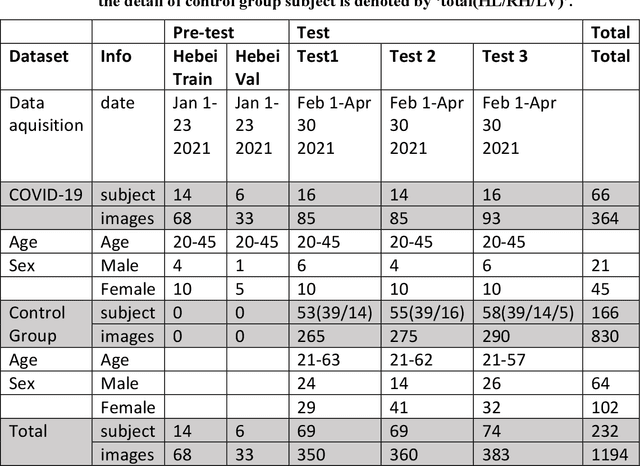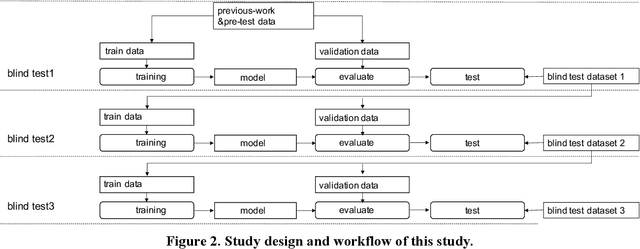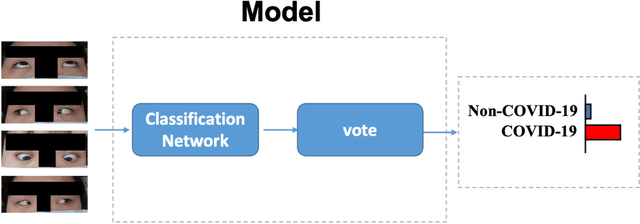Mengwei Gu
The Report on China-Spain Joint Clinical Testing for Rapid COVID-19 Risk Screening by Eye-region Manifestations
Sep 18, 2021



Abstract:Background: The worldwide surge in coronavirus cases has led to the COVID-19 testing demand surge. Rapid, accurate, and cost-effective COVID-19 screening tests working at a population level are in imperative demand globally. Methods: Based on the eye symptoms of COVID-19, we developed and tested a COVID-19 rapid prescreening model using the eye-region images captured in China and Spain with cellphone cameras. The convolutional neural networks (CNNs)-based model was trained on these eye images to complete binary classification task of identifying the COVID-19 cases. The performance was measured using area under receiver-operating-characteristic curve (AUC), sensitivity, specificity, accuracy, and F1. The application programming interface was open access. Findings: The multicenter study included 2436 pictures corresponding to 657 subjects (155 COVID-19 infection, 23.6%) in development dataset (train and validation) and 2138 pictures corresponding to 478 subjects (64 COVID-19 infections, 13.4%) in test dataset. The image-level performance of COVID-19 prescreening model in the China-Spain multicenter study achieved an AUC of 0.913 (95% CI, 0.898-0.927), with a sensitivity of 0.695 (95% CI, 0.643-0.748), a specificity of 0.904 (95% CI, 0.891 -0.919), an accuracy of 0.875(0.861-0.889), and a F1 of 0.611(0.568-0.655). Interpretation: The CNN-based model for COVID-19 rapid prescreening has reliable specificity and sensitivity. This system provides a low-cost, fully self-performed, non-invasive, real-time feedback solution for continuous surveillance and large-scale rapid prescreening for COVID-19. Funding: This project is supported by Aimomics (Shanghai) Intelligent
A New Screening Method for COVID-19 based on Ocular Feature Recognition by Machine Learning Tools
Sep 04, 2020Abstract:The Coronavirus disease 2019 (COVID-19) has affected several million people. With the outbreak of the epidemic, many researchers are devoting themselves to the COVID-19 screening system. The standard practices for rapid risk screening of COVID-19 are the CT imaging or RT-PCR (real-time polymerase chain reaction). However, these methods demand professional efforts of the acquisition of CT images and saliva samples, a certain amount of waiting time, and most importantly prohibitive examination fee in some countries. Recently, some literatures have shown that the COVID-19 patients usually accompanied by ocular manifestations consistent with the conjunctivitis, including conjunctival hyperemia, chemosis, epiphora, or increased secretions. After more than four months study, we found that the confirmed cases of COVID-19 present the consistent ocular pathological symbols; and we propose a new screening method of analyzing the eye-region images, captured by common CCD and CMOS cameras, could reliably make a rapid risk screening of COVID-19 with very high accuracy. We believe a system implementing such an algorithm should assist the triage management or the clinical diagnosis. To further evaluate our algorithm and approved by the Ethics Committee of Shanghai public health clinic center of Fudan University, we conduct a study of analyzing the eye-region images of 303 patients (104 COVID-19, 131 pulmonary, and 68 ocular patients), as well as 136 healthy people. Remarkably, our results of COVID-19 patients in testing set consistently present similar ocular pathological symbols; and very high testing results have been achieved in terms of sensitivity and specificity. We hope this study can be inspiring and helpful for encouraging more researches in this topic.
 Add to Chrome
Add to Chrome Add to Firefox
Add to Firefox Add to Edge
Add to Edge